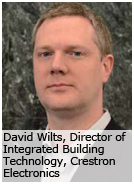“One of the key components of a security system is a battery backup, although this is not a very green solution,” said Ryan Hughson, PM at Delta Controls. “Using alternative energy sources, such as photovoltaic power, can reduce the power requirements of the system, therefore making it more efficient and last longer.”
Renewable energy sources like photovoltaic panels or wind power feed a battery bank, which in turn feeds the building's power infrastructure, Wilts added. This could easily provide the UPS for security systems in an intelligent building.
RESIDENTIAL VERSUS COMMERCIAL
 Security implementations for residential and commercial intelligent building differ in scope and complexity. “In terms of scope and capabilities, commercial-grade security management is designed more around the network, with an emphasis on the interoperability with third-party systems. There are typically more designing done to these projects,” Boriskin said. “Conversely, residential buildings often use one-vendor solution only. Except for mid- or high-rise apartment complexes, i f the residential building is a stand-alone complex, it typically would not need networking capabilities, scalability or third-party integration.”
Security implementations for residential and commercial intelligent building differ in scope and complexity. “In terms of scope and capabilities, commercial-grade security management is designed more around the network, with an emphasis on the interoperability with third-party systems. There are typically more designing done to these projects,” Boriskin said. “Conversely, residential buildings often use one-vendor solution only. Except for mid- or high-rise apartment complexes, i f the residential building is a stand-alone complex, it typically would not need networking capabilities, scalability or third-party integration.”
“This makes things both easier and harder depending on different circumstances,” Boriskin continued. “A one-vendor solution allows vendors to provide an easy-to-use system for end users. However, if other third-party systems need to be integrated into the existing infrastructure, integration would not be easy or easily modified in the field. Basically, if it doesn't come in the box then the performance is not there.”
 SUSTAINABLE FUTURE
SUSTAINABLE FUTURE
Continuous R&D efforts in greener and smarter security products will facilitate the spread of intelligent buildings to save the planet. “In the past decade or so, the focus has typically been on protecting data centers and the IT resources which enterprises own,” Bartlett said. “We now need more R&D investment in security management for non-IT assets. Vendors of sensors and actuators must work with companies that can provide an integrated hardware-software solution to embed within their products. The added cost of adding security to these devices must be absorbed using more intelligent ‘system-on-aboard' silicon design. Investments in enterprise security software solutions must be leveraged to encompass these sensors.”
Smart/green building awareness could be better promoted through education on available technology and current cost considerations. “There is a misnomer in certain areas that going green equals added costs,” Boriskin said. “Once people realize that it is an opportunity to do what is right for the environment, while bringing cost benefits, acceptance and adoption of smart/green building initiatives would increase. As of now, the up-front cost of new smart/green buildings is coming down. More governments are spreading awareness by giving tax credits and constructing public green structures that people can point to and learn from.” Energy-efficient and intelligent security products will have a chance to grow and expand with this vertical.
“We see great growth potential in this vertical and are optimistic for the market situation in the next few years,” Boriskin added.